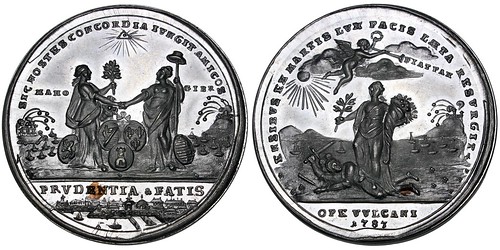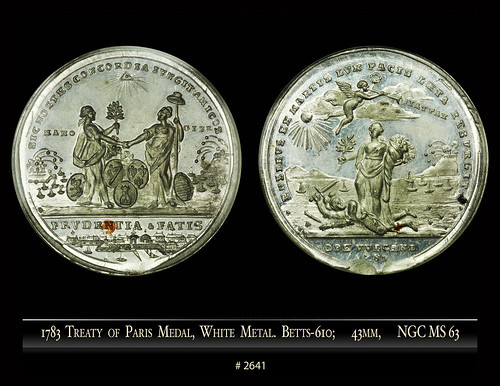
PREV ARTICLE
NEXT ARTICLE
FULL ISSUE
PREV FULL ISSUE
V25 2022 INDEX E-SYLUM ARCHIVE MORE ON THE TREATY OF PARIS MEDALPeter Jones submitted these thoughts on the Treaty of Paris medal. Thank you! -Editor I read with interest Jeremy Bostwick's listing of the Betts 610 Treaty of Paris/Peace of Versailles medal in white metal in The E-Sylum. The medal is interesting for a number of reasons. Most copies I see show the copper plug carefully placed below the exergual line on the obverse, and my medal (illustrated) shows it in almost exactly the same position. Most copies of the medal I have seen on the internet are remarkably free from the usual ugly toning seen on white metal medals, presumably from the scavenger plug. The copper plug attracts corrosion, protecting the white metal, in a similar fashion to Intercept Shield& storage products which use a patented sacrificial corrosion agent. MAHO refers to the Battle of Port Mahon on the eastern end of Minorca, which started the Seven Year's War in Europe in 1756. The battle was between the British and French. The British sent Admiral John Byng with 10 ships of the line to defend the British garrison in Minorca. But he was too timid, suffered unnecessary damage, and retreated. The next year, the British Admiralty court-martialed him and executed him for failing to fulfill orders. The GIBR on the obverse right and the similar scene on the reverse right show the British held Gibraltar defending itself firing cannon onto the French and Spanish fleets during the Great Siege of Gibraltar 1779-1783. The besiegers lost over 6,000 killed or wounded. The British garrison lost only 1,341. But the British tied up Spanish and French forces for several years. The British negotiated the Treaty of Paris during the siege. Forrer's Biographical Dictionary of Medallists lists Johan Christian Reich as engraving "Peace of Versailles". John Kraljevich also says the engraver was J. C. Reich (ca. 1740-1814), the father of the Philadelphia Mint engraver John Reich, whose German name was Johan Matthias Reich. Their family were jeton engravers. Enormous numbers of counting tokens were manufactured in Nurnberg (now Germany). However, the Reich family decided to compete. Nurnberg objected, so around 1758, the Reichs moved manufacturing to Furth, 100 miles away. They became very successful. One of his sons was John Reich (1768-1833). John emigrated to the U.S. in 1800. Some of his work caught the eye of Thomas Jefferson who appointed him to the mint in 1801. But the Mint would only give him menial tasks, so he almost left to return to Furth. But in 1807, he was appointed assistant US Mint Engraver under Chief Engraver Robert Scott until 1817, when he retired.
Some questions:
To read the earlier E-Sylum article, see:
Wayne Homren, Editor The Numismatic Bibliomania Society is a non-profit organization promoting numismatic literature. See our web site at coinbooks.org. To submit items for publication in The E-Sylum, write to the Editor at this address: whomren@gmail.com To subscribe go to: https://my.binhost.com/lists/listinfo/esylum All Rights Reserved. NBS Home Page Contact the NBS webmaster 
|


